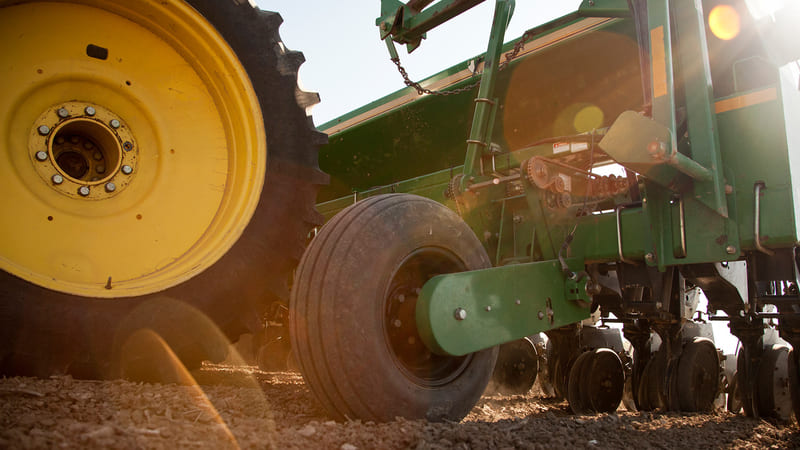Growers Say Acreage Will Be Down In 2007
Throughout the country, cotton growers are expecting a decline in cotton acres due to several factors. High prices for corn, soybeans, and other specialty crops were the primary factors cited by growers for this trend. Increasing costs of production, including the rising prices of inputs and fertilizers, were also emphasized by the respondents.
Even with the rising prices of corn and soybeans, most cotton growers said they would continue planting at least some cotton because of capital investments and their past success with the crop.
The Cotton Grower Acreage Survey also asked respondents questions regarding issues such as foreign markets, fiber quality, and precision agriculture. As the cotton market expands overseas, fiber quality and the purchasing power of foreign markets should be on all growers’ minds. As producers look for ways to minimize waste and increase efficiency, precision ag continues to become more and more popular. Finally, even in a year when cotton acreage is expected to be down, most growers on the whole continue to feel that cotton is a viable crop for the future. That is supported by the fact that more than half of the respondents said it was possible that they would purchase new equipment this year. At the very least, growers are still willing to make a capital investment in cotton’s future.
The following is a sample of growers “guesstimates” on the cotton acreage in their states for 2007 as well as their reasons for the figure.
Grower: Thomas A. Parker
State: Louisiana
Guesstimate: 450,000
More acres will be planted in corn.
Grower: Charles H. Parker
State: Missouri
Guesstimate: 500,000
There were good yields in 2004, 2005, and 2006.
Grower: Hollis Isbell
State: Alabama
Guesstimate: 518,000
The price of corn, wheat, and soybeans will take some cotton acres.
Grower: Sykes Sturdivant
State: Mississippi
Guesstimate: 1,000,000
Corn prices have escalated to a point where farmers should have locked in. Corn for feedstock and ethanol will continue to have a strong price. We now have markets for food, fiber, exports, and energy. We could easily see a bigger shift into corn if prices rally to $3.75-$4 per bushel. $3.30 corn is equivalent to 1,300 pounds of cotton at 55 cents per pound.
Grower: Robert McLendon
State: Georgia
Guesstimate: 1,100,000
Grower: Ray Young
State: Louisiana
Guesstimate: 700,000
I think more acres will be planted because of Roundup Flex Technology.
Grower: Bobby Greene, Servico Gin
State: Alabama
Guesstimate: 430,000
Several factors cause the estimate to go down. There was a poor 2006 crop, and cotton prices are low. Grain prices are high, and there is an increased rotation pattern to corn.
Extension Specialist: Bob Hutmacher, University of California
State: California
Guesstimate: 450,000-500,000
There is a continued interest is growing Pima cotton, which I guess will be planted on 325,000-350,000 acres. But concerns for a longer Pima growing season will keep a solid group if growers interested in Acala varieties on some acreage for now. Overall, cotton continues to have a hard time in some acres competing with perennial crops (trees, vines) or field crops used for dairy feed (corn, small grains, alfalfa, silage).
Grower: Talmage Crichfield Jr.
State: Tennesssee
Guesstimate: 600,000
Cotton acreage will remain about the same because of the large investment in cotton production equipment and a record 2006 crop. Corn acreage will increase at the expense of soybeans.
Grower: Larkin Martin
State: Alabama
Guesstimate: 431,000
I can’t begin to guess statewide, but our farm is seriously considering a big shift to corn. We’ve been 75%-80% cotton, and we will reduce that I’m sure. We are likely to reduce cotton acreage to 50%, with increases coming in corn and a little wheat.
Grower: Larry McClendon
State: Arkansas
Guesstimate: 950,000
Grain prices are very competitive, and cotton production costs continue to increase.
Grower: David Grant
State: North Carolina
Guesstimate: 725,000
Corn, soybeans, and wheat will take some acres.
Grower: Danny Davis
State: Oklahoma
Guesstimate: 300,000
Acreage will be down due to extreme drought. Much of the 2006 increase was new growers that had a train wreck in 2006, with little or poor level of crop insurance. The crop was terminated early and put back into small grains, and cattle is the going thing now.
Grower: Gilbert Houseley
State: California
Guesstimate: 450,000
The decrease can be attributed to three bad seasons out of the last four years. Farmers are changing to different crops.
Extension Agronomist: Charles Burmaster
State: Alabama
Guesstimate: 510,000
Because 2006 was a poor cotton year, I think we will see a lot of acres shift to corn and wheat.
Grower: Henry Allen McLaurin
State: North Carolina
Guesstimate: 730,000
With the higher prices of corn, soybeans, and wheat, many farmers in our state will shift some of their heavier or marginal cotton fields back to grains. This projection represents a 15% reduction from 2006 acres.
Extension Specialist: Chris Main
State: Tennessee
Guesstimate: 650,000
Competition from other commodities due to strong prices could reduce acres, but excellent yields and good quality will make it difficult not to plant cotton.
Grower: Frank B. Rogers III
State: South Carolina
Guesstimate: 245,000
Higher prices for wheat, soybeans and corn, as well as more peanut acres, could result in less cotton.
Grower: Don Cameron
State: California
Guesstimate: 480,000
Cotton acreage continues to decrease in California due to continual pressure from almonds, pistachio and specialty crops. Pima will continue to increase its percentage to Acala cotton.
Add charts








